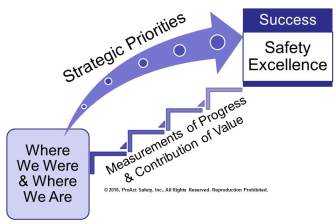Communicating Your Safety Excellence Strategy
When communicating your strategy, your audience must be able to see themselves as actors within the strategy.
What is your strategy to improve safety? If a child asked this question, could you, in a few simple sentences, clearly outline your strategy to improve safety performance and culture over the next three to five years? Sadly, many great safety professionals cannot. As Albert Einstein pointed out, "If you can't explain it to a six-year-old, you don't understand it yourself."
In our 2016 book "Inside Strategy: Value Creation from within Your Organization," 10 questions are provided to help an organization develop and execute against a strategy for shaping and getting more out of a company culture. Question nine is, "How will you create strategic alignment?" Once a strategy is created, it is vital everyone understands it and sees their role within as well. How well can you communicate your safety strategy?
While there is a lot to an effective strategy, when communicating it to others, there are four components that must be a part of communication. In the figure below, Visual Representation of Safety Excellence Strategy, this model frames these important components.

Where We Were & Where We Are
Change is the only thing constant in most corporations, but in general, people are hesitant to change and often forget change is continuously happening. It must be understood that today's reality was not the same reality of 10 years ago for many companies. What was acceptable in safety, as an example, has evolved. It is widely known that safety excellence is a journey, and everyone must understand this isn't the beginning, we have come a long way, and there is still room to improve.
Success and Safety Excellence
Success is not only the absence of injuries and incidents. I define excellence in safety as the ability to achieve great results, know precisely how you achieved those results, and still have a mindset and recognition of where opportunities are to continuously improve. While this definition has been helpful to clients, communicating success must be done in a tangible way. Define what would be the new common reality with significant safety improvement. What would be the common beliefs, knowledge, decisions, behaviors, experiences, and stories? People must be able to share a vision of safety excellence. This means it needs to be described in a way that could be observed.
Strategic Priorities
What are the three to five most important areas of focus over the next few years? I call this a one-handed strategy. If you have more strategic priorities than can be fit on the average hand, focus is needed. I would rather a client become great at a few things rather than mediocre at many things. When communicating the priorities, people need to see precisely how this will close the gap between where we are and where we are going.
Measurements of Progress and Contribution of Value
Visible progress toward a goal is one of the most effective motivators in a work setting. When success is defined in a way that would be observable, it can then be measured. This is why it is important to define success as outlined earlier. All of the suggestions provided can be measured. These measurements also provide what typical measurements in safety (results and activities) cannot: an understanding of the capturing and delivering of value. These are transformational indicators. What measurements in your strategy would tell you why you have your current results and also tell you what activity or intervention created sustainable value? This is a critical part of communicating your safety excellence strategy.
When communicating your strategy, your audience must be able to see themselves as actors within the strategy. To facilitate this, ensure your audience knows where you are going, what it will look like when you get there, where you are now, what choices were made to close the gap, their role and responsibilities, how progress will be measured, and confidence that the strategy is creating sustainable value. With this understanding, how will you describe your safety excellence strategy the next time you are asked?
This article originally appeared in the July 2016 issue of Occupational Health & Safety.